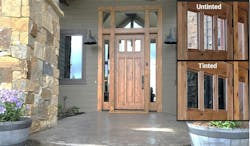Dynamic Glass Brings New Energy Savings to the Residential Market
Dynamic glass is an innovative technology that’s been used in commercial buildings for years. The glass, often used as a replacement for standard windows, utilizes electrochromic technology to tint the glass.
The concept is nothing new—tinted glasses have been around since the age of wire-frame—but this is the first we’re seeing it used in the residential market. Why is that?
Christopher Angelo, co-founder and CEO of Glass Dyenamics, believes his company has found a way to manufacture dynamic glass at a scale best equipped for residential homes. According to Angelo, this innovation has the potential to rival solar panels in terms of energy savings and feasibility.
HOW DOES DYNAMIC GLASS WORK?
When the glass is heated by the sun, a small amount of internal energy is used to dim the surface. With Glass Dyenamics, the user is able to control the amount of tint they want as well via a smartphone app. The former process is an automatic way of conserving energy by letting the temperature outside regulate how much heat enters the home.
For example, the window can be clear in the winter to allow more heat in, then tinted in the summertime to block the solar energy out. The homeowner can also use their phone to adjust the tint to their liking, regardless of external factors.
There is wiring involved in the technology, hidden through the walls and installed similarly like a doorbell, according to Angelo.
The CEO views dynamic glass technology as a worthy adversary to solar. The tinting of the glass creates less demand on a home’s cooling and heating system, and can be especially beneficial during peak energy demand hours.
“Certainly a target market is sustainable homes,” says Angelo. “The way the costs are, we can provide the same value as solar and do it for one-third of the cost.”
You see, solar power is often viewed as the poster child for transitioning to clean energy. But for Angelo, solar alone won’t cut it.
DYNAMIC GLASS AS AN ALTERNATIVE TO SOLAR?
Christopher Angelo has a history of work in the “solar coaster” industry. He is the former CFO of Silicor Materials, a solar manufacturing company. In his time at the company, Angelo manufactured 20 million solar cells.
This leaves Angelo with a unique perspective of the solar industry and its problems, as well as visions for potential solutions.
One problem: solar is too expensive for the average homeowner, with a 20+ year payback and $30,000 in installation costs.
“The average time period that someone lives in a home is eight years,” says Angelo. “And there’s a 20 year payback? What’s going on?”
Other issues he mentions are the risks involved in relying on the energy grid: Potential fluctuations in energy costs, utility companies changing the buy-back rate structure due to political change or budgetary restrictions, and even the social injustice of forcing solar-less individuals to pay the increased costs needed to maintain the grid.
"Our vision is that dynamic glass will be broadly adopted as a part of a lower cost and lower risk solution to achieve significant residential home energy efficiency, either as a compliment or alternative to rooftop solar." — Christopher Angelo, Co-founder and CEO, Glass Dyenamics
With Glass Dyenamics’ windows, a home can receive up to 20% reduction in energy costs—a statistic similar to those who use solar—at a fraction of the cost, according to Angelo.
And while solar energy is further supported through various tax credits and government bills, dynamic glass is getting there, too.
The Dynamic Glass Act of 2021 incentivized businesses to utilize electrochromic glass by including it in investment tax credits. The act was then merged into the Build Back Better bill, granting green projects eligibility for up to a 30% tax credit rate.
“Our vision is that dynamic glass will be broadly adopted as a part of a lower cost and lower risk solution to achieve significant residential home energy efficiency, either as a compliment or alternative to rooftop solar,” says Angelo.
Glass Dyenamics completed their first installation on a home in Bend, Oregon. Because homeowners are more willing to pay a premium for their front entryway, Angelo believes that is where most of the product will be used in the market today.
The company has ongoing installations and a large commercial partner to scale up production sizes.
